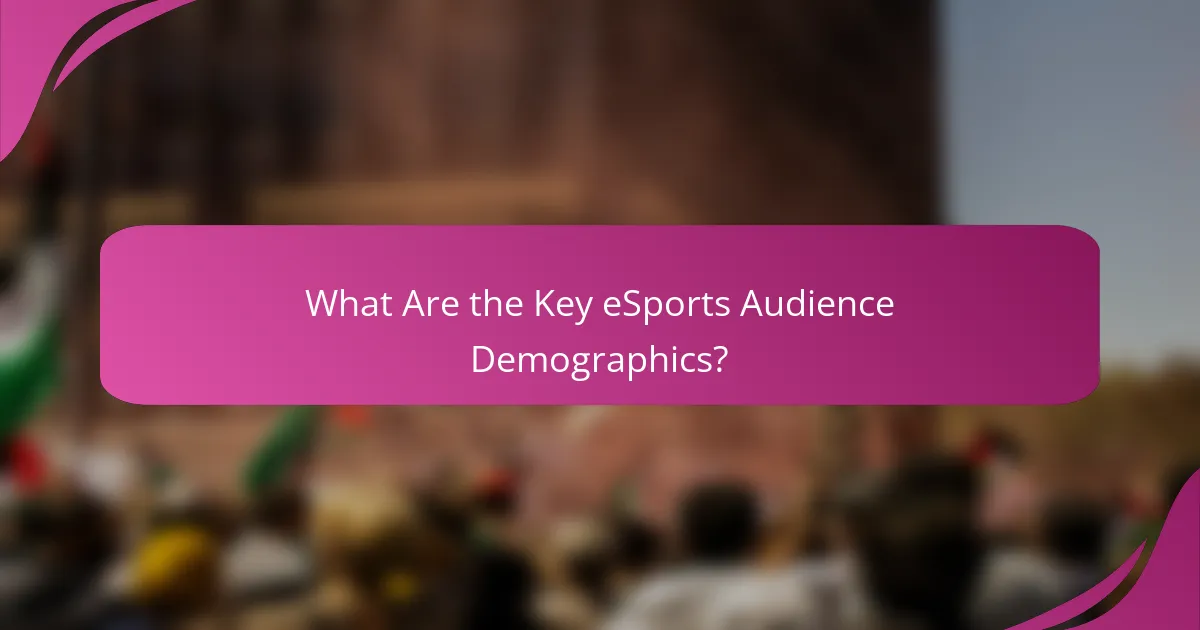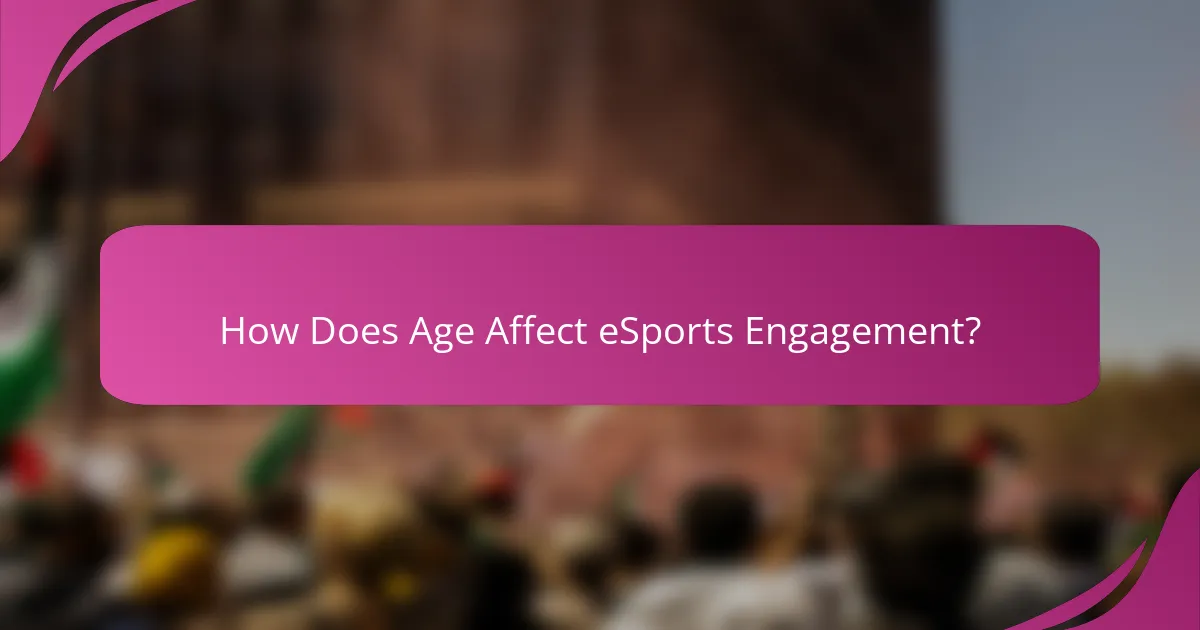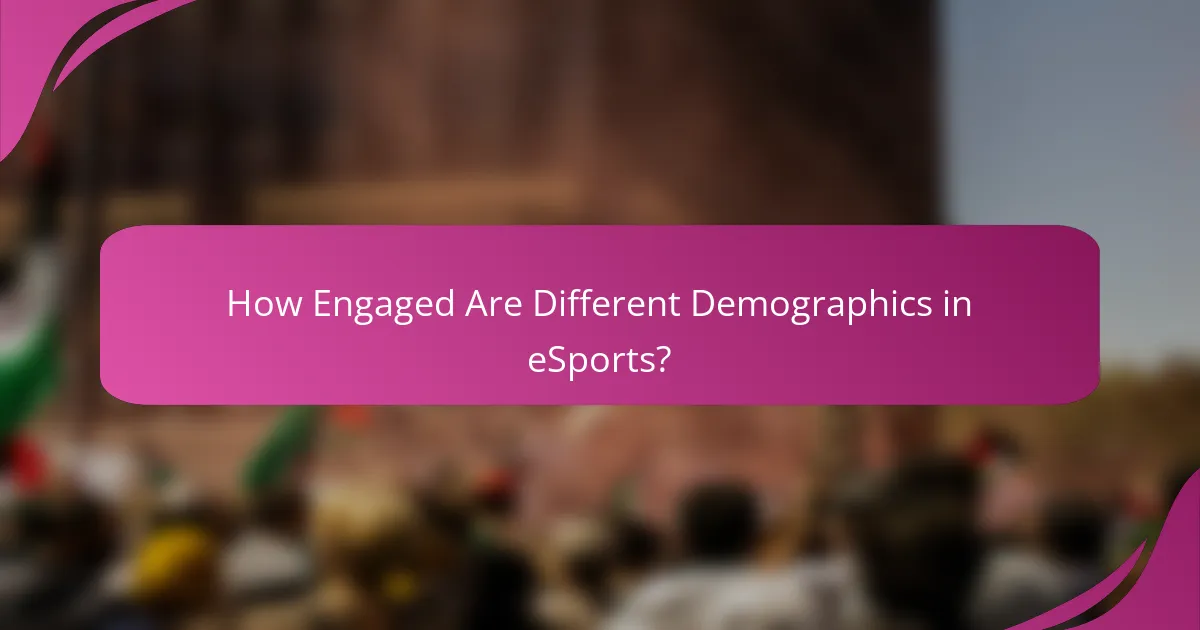The eSports audience is a vibrant mix of demographics, encompassing various ages, genders, and interests. Recognizing these characteristics is essential for brands and organizations looking to effectively engage with this expanding market. Age plays a pivotal role in shaping gaming preferences and viewing habits, while the gender distribution, although predominantly male, is seeing a rise in female participation.

What Are the Key eSports Audience Demographics?
The key eSports audience demographics reveal a diverse group of viewers characterized by age, gender, interests, and engagement levels. Understanding these demographics is crucial for brands and organizations aiming to connect effectively with this growing market.
Age distribution of eSports viewers
The age distribution of eSports viewers typically skews younger, with a significant portion of the audience falling between 18 and 34 years old. This demographic is often referred to as Generation Z and Millennials, who are more likely to engage with digital content and gaming.
However, there is also a notable presence of viewers aged 35 and older, indicating that eSports is appealing to a broader age range. This trend suggests that eSports can attract both younger audiences and older fans who have developed an interest in competitive gaming.
Gender breakdown in eSports
The gender breakdown in eSports shows a predominance of male viewers, with estimates indicating that around 70-80% of the audience is male. However, the female audience is growing steadily, now comprising about 20-30% of eSports fans.
This increase in female viewership highlights the importance of creating inclusive content and marketing strategies that appeal to a diverse audience. Brands that recognize and cater to this demographic can enhance their reach and engagement within the eSports community.
Interests of eSports fans
eSports fans typically have a strong interest in gaming, technology, and competitive sports. Many viewers enjoy not only watching tournaments but also participating in gaming themselves, whether casually or competitively.
In addition to gaming, eSports fans often engage with related content such as streaming, gaming news, and social media discussions. This multifaceted interest allows brands to connect with fans through various channels, enhancing their overall experience.
Engagement levels among demographics
Engagement levels among eSports demographics can vary significantly, with younger viewers generally exhibiting higher engagement through platforms like Twitch and YouTube. These platforms allow for real-time interaction, fostering a sense of community among fans.
Older viewers may engage less frequently but often consume content through traditional media or recorded streams. Understanding these engagement patterns can help brands tailor their marketing strategies to effectively reach different segments of the audience.

How Does Age Affect eSports Engagement?
Age significantly influences eSports engagement, shaping preferences for games, platforms, and viewing habits. Younger audiences tend to be more active participants, while older demographics often engage as viewers or casual gamers.
Age groups and their gaming preferences
Younger players, typically aged 18-24, favor fast-paced competitive games like first-person shooters and battle royales. This age group is also more likely to participate in online tournaments and streaming platforms.
In contrast, players aged 25-34 often gravitate towards strategy games and multiplayer online battle arenas (MOBAs). They may engage in gaming as a social activity, balancing it with professional commitments.
Older gamers, aged 35 and above, usually prefer casual games or nostalgic titles. Their gaming sessions are often shorter, focusing on relaxation rather than competition.
Impact of age on viewing habits
Viewing habits vary across age groups, with younger audiences more inclined to watch live streams and eSports tournaments on platforms like Twitch and YouTube. They enjoy interactive content and often engage with streamers through chat.
Middle-aged viewers, aged 25-34, tend to watch major tournaments and follow specific teams or players. They appreciate high production values and may watch highlights or recorded matches rather than live streams.
Older viewers, particularly those over 35, often engage with eSports through traditional media or curated content. They may prefer watching highlights or summaries rather than live events, reflecting their time constraints and viewing preferences.

What Is the Gender Distribution in eSports?
The gender distribution in eSports shows a significant male majority, although female participation is steadily increasing. Understanding this demographic is crucial for game developers, marketers, and event organizers aiming to engage diverse audiences.
Male vs. female audience statistics
The eSports audience is predominantly male, with estimates suggesting that around 70-80% of viewers identify as male. However, female viewership has been growing, particularly among younger audiences, with some reports indicating that female gamers can make up 20-30% of the total audience in certain titles.
In competitive gaming, the gender gap is narrowing, especially in games that emphasize teamwork and social interaction. Events and tournaments are increasingly attracting female participants, which can lead to a more balanced audience over time.
Gender-specific gaming interests
Male gamers often gravitate towards competitive and action-oriented genres such as first-person shooters and battle royale games. In contrast, female gamers may show a preference for social and casual gaming experiences, including multiplayer online battle arenas and simulation games.
Understanding these interests can help brands tailor their marketing strategies. For instance, games that incorporate community-building features or storytelling elements may appeal more to female audiences, while competitive leagues and tournaments might attract more male viewers.

What Interests Drive eSports Viewership?
eSports viewership is primarily driven by the interests in competitive gaming, community engagement, and the social aspects surrounding popular titles. Fans are drawn to specific games and genres that resonate with their preferences, often influenced by trends in gaming culture and social media interactions.
Popular game genres among audiences
First-person shooters (FPS), multiplayer online battle arenas (MOBAs), and battle royale games are among the most popular genres that attract eSports audiences. Titles like “League of Legends,” “Counter-Strike: Global Offensive,” and “Fortnite” dominate viewership due to their competitive nature and engaging gameplay.
These genres often foster vibrant communities, encouraging players to participate in tournaments and watch live streams. The excitement of competition and the chance to see skilled players in action keep audiences engaged and returning for more.
Influence of social media on interests
Social media plays a crucial role in shaping the interests of eSports viewers. Platforms like Twitch, YouTube, and Twitter allow fans to connect with players, follow events, and share content, significantly enhancing their engagement with the eSports scene.
Content creators and influencers often drive trends by showcasing gameplay, sharing highlights, and providing commentary. This interaction not only boosts interest in specific games but also helps build a sense of community among fans, making them more likely to tune in to live events and tournaments.

How Engaged Are Different Demographics in eSports?
Engagement levels in eSports vary significantly across different demographics, particularly age and gender. Understanding these differences helps brands and organizers tailor their strategies to effectively reach and engage their target audiences.
Engagement metrics by age and gender
Younger audiences, particularly those aged 18 to 34, show the highest engagement in eSports, often participating in both viewing and playing. In contrast, older demographics, such as those over 50, tend to engage less frequently, primarily as viewers rather than active participants.
Gender also plays a role in engagement metrics. While male audiences dominate the eSports scene, female viewership has been steadily increasing, especially in specific game genres. This shift indicates a growing interest among women, which brands should consider when developing marketing campaigns.
Factors influencing audience engagement
Several factors influence how different demographics engage with eSports. Game genre is crucial; competitive titles like first-person shooters attract younger players, while strategy games may appeal more to older audiences. Additionally, social interaction through platforms like Twitch enhances engagement by allowing viewers to connect with streamers and each other.
Accessibility is another important factor. The availability of games on multiple platforms, including mobile, has expanded the audience base. Brands should ensure their content is accessible across devices to capture a broader demographic and enhance overall engagement.

What Are the Trends in eSports Audience Growth?
eSports audience growth is characterized by increasing viewership across diverse platforms, with millions tuning in for competitive gaming events. This trend is driven by a younger demographic, expanding global reach, and rising interest in gaming as a mainstream entertainment option.
Emerging demographics in eSports
The eSports audience is becoming more diverse, with significant representation from various age groups and genders. While traditionally dominated by males aged 18-34, recent data shows a growing number of female viewers and older participants, reflecting a shift in gaming culture.
Additionally, interest in eSports spans across different regions, with notable growth in Asia, North America, and Europe. This geographic expansion is fueled by local tournaments and increased accessibility through streaming platforms.
Future projections for audience growth
Future projections indicate that the eSports audience could reach hundreds of millions globally within the next few years. Factors contributing to this growth include advancements in technology, increased sponsorship deals, and the integration of eSports into traditional sports events.
To capitalize on this trend, stakeholders should focus on enhancing viewer engagement through interactive content and community-building initiatives. Understanding audience preferences will be crucial for brands and organizations aiming to thrive in this evolving landscape.
